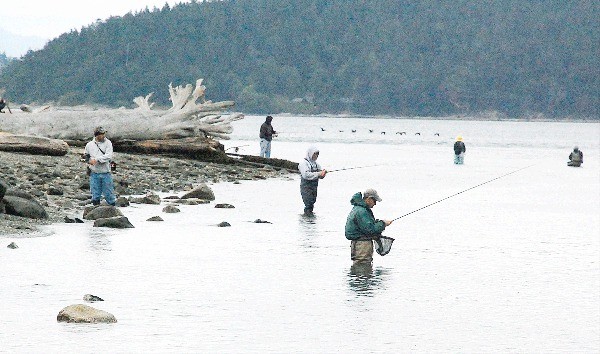A project designed to protect and restore Ala Spit on North Whidbey has some local fisherman and park regulars scratching their heads.
The restoration effort, which will begin Monday and run through October, aims to reduce erosion, protect long-term public access and restore juvenile salmon habitat by removing rip-rap put in along the spit’s neck in the late 1960s.
But some who frequent the park question the logic behind the plan. They are wondering how removing the rip-rap will work to reduce erosion when that is just what such shore-armoring is designed to protect in the first place.
According to Jill Wood, environmental health director for Island County Public Health, the work that will begin next week has been planned for years. It’s actually the second of what will likely be a three-phase project.
The county first purchased the park in the 1990s with Conservation Futures funds, derived from a property tax. Wood said the county hadn’t had the park for long before officials began to notice that it was changing, namely the neck of the spit just to the left of the parking lot. It appeared to be getting thinner due to erosion.
In phase one, the county hired Herrera Environmental Consultants, a regional firm, to perform a two-year feasibility study that investigated the issue. The results largely determined the work outlined in phase two.
According to the study’s executive summary, the “rip-rap revetment artificially holds in place the lower third of the spit and cuts off the supply of sediment and large woody debris to the southern end of the pocket estuary.”
“This occurs because the natural transport of sediment over the berm of the beach during storms is interrupted by the rip-rap revetment. Over time, this has resulted in sediment starvation in the pocket estuary, degrading the habitat quality,” the study said.
The rip-rap to be removed consists of large boulders and crushed chunks of concrete. The county is requiring the contractor to leave behind all driftwood presently on the beach as a form of natural shoreline armoring.
The study also identified a concrete bulkhead and rock groin located to the south of the parking lot as having a negative impact. However, due to limited funds, its removal will have to be done in phase three.
Wood said she didn’t know when that would occur but that it would likely be sometime in the next few years. To date, phases one and two total about $502,000.
When asked what they thought about the project Thursday morning, several fishermen expressed concerns about the plan. Jim Matteucci, an Oak Harbor resident, said the rip-rap and bulkhead were installed for a reason and that removing them will only result in later problems.
“If you take this out of here, Mother Nature is going to take the parking lot,” Matteucci said.
He worries removing the rip-rap will result in a breach of the spit, which he believes will hurt, rather than enhance, the fishing ground. Finally, he complained that the project was ill timed, as it cuts off the tail end of the humpie salmon season and much of the silver season.
Mike Lang, also of Oak Harbor, said he’d been fishing from the spit for years. While he’s not worried about the loss of fishing grounds, saying Whidbey has plenty of beaches, he said he had trouble seeing the benefits of the project.
“To me, it’s just a terrible waste of money,” he said.
Addressing concerns about a possible breach, Wood said phase two of the restoration project is designed to ensure that doesn’t happen. While it seems counter productive to remove rip-rap to solve erosion problems, the study makes it clear it is the problem.
“It’s doing the complete reverse of its intention,” Wood said.
As for timing, the permit window is between the months of July and October. Wood said it was decided to perform the work after Labor Day in hopes of reducing the impact as much as possible to the general public.
“I hope people will look at this in a preventative way,” Wood said. “Right now it’s (the rip-rap) a threat. … What we’re doing is proactive rather than retroactive.”




